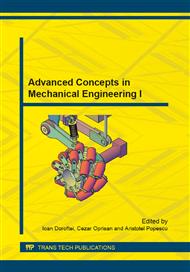[1]
P.S. Marek, Enfermagem Médico-Cirúrgica - Conceitos e Prática Clínica, Volume IV, sixth ed. Lusociência, (2003).
Google Scholar
[2]
S.L. Lin, N.R. Guo, C.C. Chiu, Modeling and Simulation of Respiratory Control with LabView. Journal of Medical and Biological Engineering. 632(1) (2012) 51-60.
Google Scholar
[3]
K.V. Lakshmi, P. Srinivas, Modeling, Simulation and Analysis of Lung Mechanics Using LabView, International Journal of Engineering Research & Technology (IJERT). 1(6) (2012) 1-87.
Google Scholar
[4]
S. Mesic, R. Babuska R., H.C. Hoogstedem, A.F.M. Verbraak, Computer-Controlled Mechanical Simulation of the Artificially Ventilated Human Respiratory System, IEEE Transactions on Biomedical Engineering. 50(6) (2003) 731-743.
DOI: 10.1109/tbme.2003.812166
Google Scholar
[5]
J.B. West, Respiratory Physiology: The Essentials, eighth ed., Lippincott Williams & Wilkins, Philadelphia, (2008).
Google Scholar
[6]
F. -S.F. Yao, Asthma and Chronic Obstructive Pulmonary Disease, in: F. -S.F. Yao, V. Malhora, M.L. Fontes (Eds. ), Yao and Artusio's Anesthesiology: Problem-Oriented Patient Management, seventh ed., Lippincott Williams & Wilkins, Philadelphia, 2011, Chapter 1, pp.3-28.
Google Scholar
[7]
A.F.M. Verbraak, P.R. Rijnbeek, J.E. Beneken, J.M. Bogaard, A. Versprille, A new approach to mechanical simulation of lung behavior: pressure-controlled and time-related piston movement, Med. Biol. Eng. Comput. 39(1) (2001) 82–89.
DOI: 10.1007/bf02345270
Google Scholar
[8]
A.F.M. Verbraak, J.E.W. Beneken, J.M. Bogaard, A. Versprille, Computer-Controlled Mechanical Lung Model for Application in Pulmonary Function Studies. Med. Biol. Eng. Comput. 33 (1995) 776-783.
DOI: 10.1007/bf02523009
Google Scholar
[9]
A.F.M. Verbraak, W. Holland, B. Mulder, J.M. Bogaard, A. Versprille, Computer-Controlled Flow Resistance. Med. Biol. Eng. Comput. 37 (1999) 770-775.
DOI: 10.1007/bf02513380
Google Scholar
[10]
S. Mesic, R. Babuska, H.C. Hoogstedem, A.F.M. Verbraak, Computer-Controlled Mechanical Simulation of the Artificially Ventilated Human Respiratory System, IEEE Transactions on Biomedical Engineering. 50(6) (2003) 731-743.
DOI: 10.1109/tbme.2003.812166
Google Scholar
[11]
P. Barbini, G. Cevenini, G. Avanzolini, Nonlinear Mechanisms Determining Expiratory Flow Limitation in Mechanical Ventilation: A Model-Based Interpretation, Annals of Biomedical Engineering. 31 (2003) 908-916.
DOI: 10.1114/1.1590665
Google Scholar
[12]
D.H. Arnold, D.M. Spiro, R.A. Desmond, J.S. Hagood, Estimation of airway obstruction using oximeter plethysmograph waveform data, Respiratory Research. 6(65) (2005). doi: 10. 1186/1465-9921-6-65.
DOI: 10.1186/1465-9921-6-65
Google Scholar
[13]
E. Correger, G. Murias, E. Chacon, A. Estruga, B. Sales, J. Lopez-Aguilar, J. Montanya, U. Lucangelo, O. Garcia-Esquirol, A. Villagra, J. Villar, R.M. Kacmarek, M.J. Burgueno, L. Blanch, Interpretation of Ventilator Curves in Patients With Acute Respiratory Failure. Medicina Intensiva. 36(4) (2012).
DOI: 10.1016/j.medine.2012.06.001
Google Scholar


